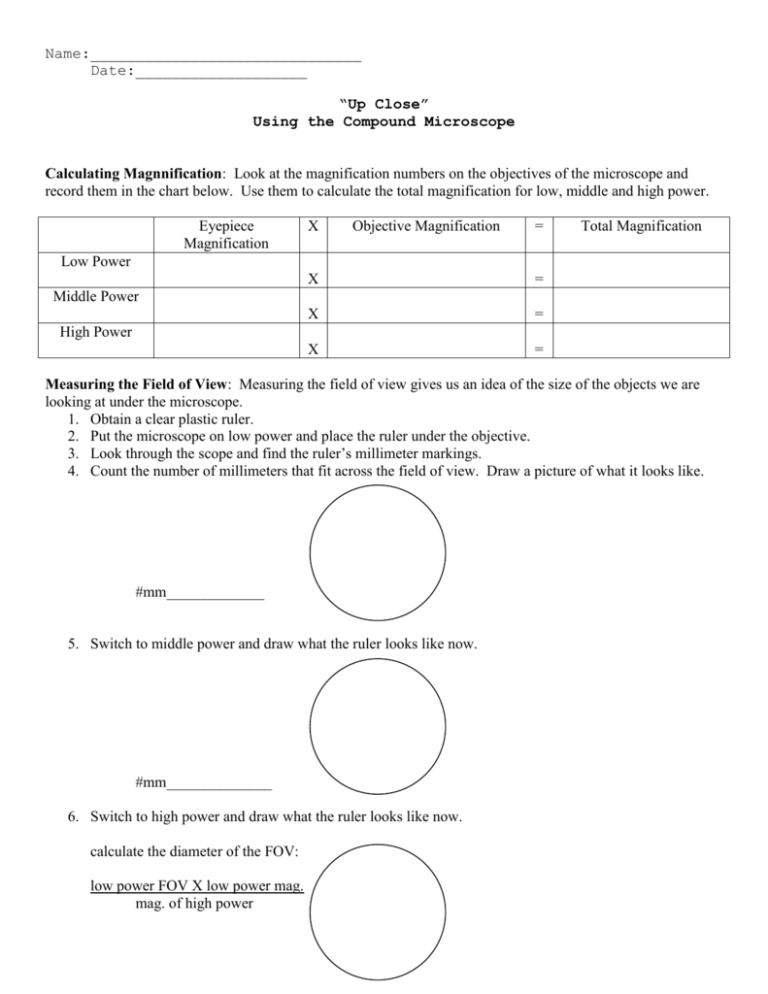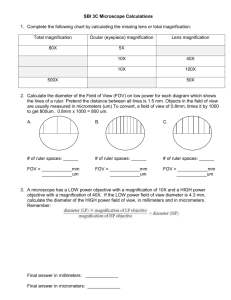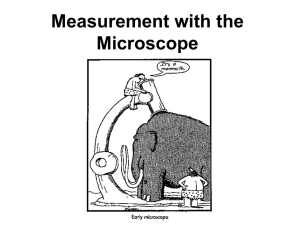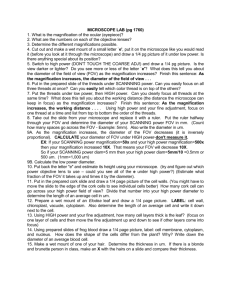Microscope Lab: Magnification & Field of View Worksheet
advertisement

Name:______________________________ Date:___________________ “Up Close” Using the Compound Microscope Calculating Magnnification: Look at the magnification numbers on the objectives of the microscope and record them in the chart below. Use them to calculate the total magnification for low, middle and high power. Eyepiece Magnification X Objective Magnification = Total Magnification Low Power X = X = X = Middle Power High Power Measuring the Field of View: Measuring the field of view gives us an idea of the size of the objects we are looking at under the microscope. 1. Obtain a clear plastic ruler. 2. Put the microscope on low power and place the ruler under the objective. 3. Look through the scope and find the ruler’s millimeter markings. 4. Count the number of millimeters that fit across the field of view. Draw a picture of what it looks like. #mm_____________ 5. Switch to middle power and draw what the ruler looks like now. #mm______________ 6. Switch to high power and draw what the ruler looks like now. calculate the diameter of the FOV: low power FOV X low power mag. mag. of high power Viewing Specimens: Optical Tricks with the Microscope: What happens when it moves right/left? What happens when I change magnification? 1. Obtain a prepared “e” slide and place it on the microscope stage the way you would normally look at it. 2. View the “e” under middle power and draw what you see. 3. Move the slide to the right and record what direction the object seems to move. Move the slide to the left. What direction did the object move this time? Counting and Calculating the Size of Microscopic Objects: We often need to estimate the size of objects we see under the microscope to get an idea of their size in relation to other objects. 1. Obtain a slide and place some salt crystals (in a single layer) on the slide and place under the microscope. 2. View the crystals under low power, draw what you see and count the number of salt crystals visible. #crystals_________ 3. Change the magnification to middle power. Draw and count. Estimate the size of ONE crystal. Diameter of FOV (in mm) # of crystals that fit across = size of ONE crystal 4. Change the magnification to high power. Draw what you see. Questions: Answer the following questions IN COMPLETE SENTENCES! 1. What happens to the size of the object when you change magnification from low to high power? 2. Describe what happens to the size of the FOV you see as you change from low to high power? 3. Why is it easier to locate objects when you observe them under low power than under high power? 4. Describe the relationship between the direction you move the slide and the direction the object appears to move. 5. If a single-celled organism appeared to be swimming toward the upper right edge of the field of view, in what direction would you move the slide to keep the organism in sight?











